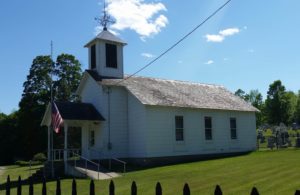Andebit et beaqui corendit, ut quostes esciendion re dit ad et prae parion es quia quas alibus sam, omnim faciden ducipidiat arum autem nobis enis es voat

9. The White Church
Heritage Connects Us All
Listen to the Audio Narration of Site 9 of the Iron Story

Built in 1812, the White Church Road was the first route of land travel in the town. Most traffic up and down the Champlain Valley was conducted on Lake Champlain itself, which meant that no road was closer to the shore than White Church Road. After 1812, this road was the main road from Crown Point to Plattsburgh. The present road (Route 22/Route 9) along Lake Champlain did not exist until the early 1900s. By the early 1920s, automobile travel soon overtook other methods of transportation.
Roads that did exist in the early days were at best rough and narrow. Transporting bulky, heavy materials in small wagons was a challenge to be reckoned with. One of the earliest roads of the area was Roger’s Road, which played an important role in opening access to the interior of the Adirondacks. Established in the 1790s, it connected Elizabethtown, Lewis, and Schroon Lake. When the Champlain Canal connected Lake Champlain and the Hudson River in 1823, it became possible to ship iron directly by water to larger markets. Transportation by water, however, was closed during the colder months when the lake would freeze.
Travel Tools
The White Church sits on the corner of Treadwell Road and White Church Road. After visiting the church and cemetery, turn left (north) onto White Church Road and head toward Moriah.![]()
![]()
First Person Account:
The perils of land transportation. The trip described began in Crown Point, taking the Carthage Road west to Roger’s Road: “I left the boat at Crown Point, hired a man to take me by buggy back into the country till we struck the north and south road…that perilous ride is indelibly imprinted on my memory, when in Egyptian darkness on a lonely road edged on one side by a rapidly flowing creek, and on the other by a precipitous mountainside, my driver said, “I believe we are going to meet an ox team drawing a charcoal wagon.” I asked, “Why do you think so, you can’t see them.” He said, “but I hear the peculiar snort of the oxen betokening alarm, and I feel through the lines my horse’s trepidation.” In a few moments, the two teams had almost touched each other. A short conference result in our cautiously climbing out of our buggy, and pulling it by main force of the three of us as far up the mountainside as possible, and then by the use of a whip and a handkerchief measuring to see what room the charcoal wagon had to pass in, and with one more boost of the buggy the passage was safely made. Driving soberly a few miles further I asked how soon we might expect to reach Roth’s Tavern. He said, “Do you see that light down there?” “Yes” “Well there, if we ever get there we will put up for the night.” The light appeared to be almost perpendicular beneath us, but he said it was over 5 miles away by wagon-road. As he had a trusted horse, sure-footed, he did not attempt to guide him, but let him go his own gait, and act on his own judgment so to speak, and after about two hours he reached the tavern.” -Chas. Stewart, a buyer of Adirondack bloomery iron on a trip to Roth’s Forge during the Civil War


